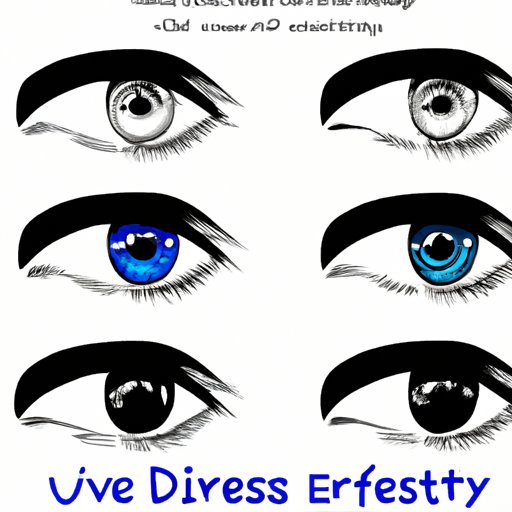Introduction
As the windows to the soul, eyes have always fascinated humans. They come in different shapes, sizes and colors, but it’s the color of our eyes that tends to be the most noticeable feature when we meet somebody new. Eye color is determined by a combination of genetics, ethnicity and environmental factors. Understanding the reasons behind eye color can not only give insight into our physical traits but also into our cultural differences.
The color of our eyes is determined by a variety of factors, each playing a crucial role in the final shade of our eyes. In this article, we’ll explore the genetics behind eye color, debunk some common myths and explore the cultural significance of eye color. We’ll also explain why your eye color might change over time and what that could mean for your health.
What Determines Human Eye Color: The Genetics Behind the Shades
Eye color is a polygenic trait, which means that multiple genes from both parents regulate it. Eye color is largely determined by the amount and type of melanin, a pigment found in the iris, which is part of the uveal tract inside our eyes. Increased melanin gives rise to darker eye color, while decreased melanin gives lighter eye color. The amount, type and location of melanin within the eye can vary, depending on the individual’s genetic makeup.
The specific genes involved in determining eye color are not fully understood, but researchers have discovered two particular genes that play a big role in determining eye color inheritance: OCA2 and HERC2. OCA2 gene is responsible for producing the P protein, which determines the amount of melanin produced. HERC2 gene regulates the expression of the OCA2 gene. If a person has two alleles (variants) that produce melanin, they will have brown eyes because of the high amount of melanin produced. Individuals with lesser melanin produced have lighter colored eyes, such as blue or green.
Unraveling the Mystery of Eye Color: Facts and Myths
There are many myths surrounding eye color. One popular belief is that certain eye colors are more prone to conditions such as near or farsightedness. However, researchers have found no scientific evidence to support this claim. Another belief is that people with lighter eye color are more sensitive to pain, which also has no scientific basis. However, there are some facts about eye colors that are not widely known. For example, only 1-2% of the world’s population have green eyes, making them one of the rarest eye colors.
Another fascinating fact is that most babies are born with blue or grey eyes which could change depending upon the genes that get activated during the first year of life. Lastly, eye color could be multi-colored as well which is known as heterochromia.
Exploring the Diversity of Human Eye Colors Across the Globe
Eye color is not evenly distributed around the world. The distribution of eye colors is mostly influenced by the ethnicity and ancestry of a specific population. Brown is the most common eye color globally, as it is dominant in people of African, Asian and South American descent. Green and hazel eyes are most commonly found in individuals of European descent, and blue eyes are highly prevalent in individuals from the Baltic area, Scandinavia, and Eastern and Western Europe.
Interestingly, some places have been recognized for their unique eye color diversity, such as Iceland, where around 80% of the population has either blue or green eyes. Central Asia is also known for its variety of eye colors, which include brown, green, blue and grey. The geographical location and cultural diversity have played an essential role in the variety of eye color found across different countries.
The Cultural Representations of Eye Color and Their Significance
Eye color has been perceived differently across various cultures. In some ancient cultures, blue eyes had been regarded as a sign of divinity or spiritual strength. In others, people with green and blue eyes were believed to hold magical powers. Conversely, in some cultures, individuals with darker eyes were viewed as more trustworthy than those with lighter eyes, while in other cultures, they were viewed as being fearful and untrustworthy.
The cultural significance of eye color has since evolved but still holds importance in some communities. In some places, it’s believed that people with brown eyes are more sexually active than those with other eye colors. In some cultures, lighter eyes are still perceived as more beautiful, while in others, darker eyes are viewed as alluring and mysterious.
Why Your Eye Color Might Change Over Time and What It Says About Your Health
Eye color may change or darken due to medical conditions such as glaucoma, Fuch’s heterochromic cyclitis, or iron overload. Certain medications or drugs (like prostaglandin analogs) may also cause eye color change due to their potential to increase melanin production.
Moreover, normal aging may cause a change in eye color or tone. The change in eye color is not necessarily a health concern; however, the change in tone could be raising a concern. For example, a sudden darkening of the eye could be a sign of pigment dispersion syndrome or pigmentary glaucoma. It’s essential to speak with an eye doctor if you notice a significant change in your eye color or tone, as it could indicate a severe medical condition.
Conclusion
Eye color is an intriguing trait and has a complex genetic and biological basis. It’s fascinating to see how it has evolved over time and become a part of our cultural and social identity. Understanding the factors behind eye color can help us gain insight into our ancestry, evolution, and medical well-being. Hopefully, this article has provided some valuable insights into the topic and helped shed some light on the myths surrounding eye color.
